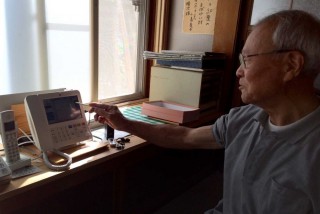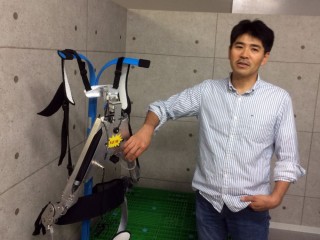Loading
Search
▼ Tools in aging Japan: Robotic spines & Segway-like stools
- Category:Other

SF GATE
HINOEMATA, Japan — The video phone in Hirando Hoshi’s living room rings.
Hoshi, a trim man in his late 70s, kneels on the floor and taps the phone as a cold wind outside strips autumn leaves from the trees. The public health nurse for his small mountain village appears, her warm face filling the phone’s screen.
Seated just up the road in Hinoemata’s town hall, the nurse has been studying Hoshi’s blood pressure. Hoshi measured it a few minutes ago, here at home, and logged the results with a wireless device. The readings seem high this morning, she says. He assures her that he’s fine.
“I have a kind of emotional relief, security, that someone is watching, taking care of me,” said Hoshi, 77, a retired municipal worker, after the call.
Japan is turning to technology to deal with one of the country’s biggest problems — a rapidly aging population.
Almost 26 percent of Japanese are at least 65 years old, the highest proportion of any nation. And that number will almost certainly rise. Long lifespans, minimal immigration and one of the world’s lowest birthrates — 1.4 children per woman — are slowly shrinking the population, creating a nation in which the old will one day outnumber the young.
Prime Minister Shinzo Abe has made stopping the country’s demographic implosion a top priority. He has pushed for measures that will encourage young Japanese to have children, such as adding enough day care centers to accommodate 400,000 kids. He has argued for deep changes in Japan’s corporate culture and broader society, which have forced most women to choose between motherhood and careers.
But even if Abe’s “womenomics” succeed, Japan will have a large elderly population in need of care. So the country has called on one of its traditional strengths — advanced technology — to cope.
How tech helps
While so much consumer technology caters to the needs, wants and whims of the young, Japanese companies are exploring ways tech can aid the old. They include devices that enable retirees to maintain their independence by helping them move around the home or performing chores. Some even see the creation of humanoid robots — a dream actively pursued by many Japanese engineers — as a way to care for the elderly, providing artificial household servants.
By that standard, the system linking Hoshi with his community nurse seems simple, even modest. But it works.
NTT East, a subsidiary of Japan’s dominant telecommunications company, set it up four years ago as an experiment. The company chose Hinoemata as its laboratory because of the town’s small, graying population and remote location high in the wooded mountains of central Japan. Getting there from the nearest city takes more than two hours on twisting roads.
NTT distributed video phones as well as pedometers, scales and blood pressure monitors equipped to transmit their data wirelessly. Sixty-eight people, ages 30 to 91, agreed to take part. The community nurse, Tachibana Mayumi, can see their health data and keeps an eye out for anything wrong.
Hoshi and his wife, who teaches calligraphy, have two grown sons who moved to Yokohama, 180 miles away, to find jobs. The NTT system gives Hoshi assurance.
“I don’t want to move,” he said, speaking through an interpreter. “I was born in this village. It’s very peaceful. The city is not comfortable for me. Too much noise.”

Expanding program
NTT tried similar systems in two other communities and is now considering an expansion of the program, seeing it as a way to sell online services to the elderly. Participation costs users about $55 a month, although in Hinoemata, the village government covered most of that.
“The younger generation — they already know how to use the Internet,” said Ishida Hideki, business promotion manager with NTT East. “If we can invent this kind of easy system for the elderly, there’s the opportunity for more profit.”
While Hoshi remains fit, many people his age have already lost strength or mobility. That’s where Professor Hiroshi Kobayashi’s “muscle suit” comes in.
The contraption looks like a rigid aluminum backpack frame, with two paddles that reach around the hips and rest on the upper thighs. Push one botton and the frame relaxes, allowing the wearer to bend over and grab something heavy off the floor. Push another button, and the frame snaps upright, taking the wearer with it. Wearing it feels something like being a puppet.
“You don’t have to use your own back power,” said Kobayashi, a professor in the mechanical engineering department of the Tokyo University of Science. “You just have to trust the muscle suit.”
He has distributed 110 of the suits so far and has formed a company, Innophys, to sell them, anticipating a price of $6,000 or less. The suits could help older people stay independent, he says. They could also help nurses and other caregivers lift the infirm out of bed, chairs or baths.
“That’s very hard work,” said Kobayashi, whose shy smile and bed-head hair fit the image of eccentric inventor. “As an engineer, I want to develop something useful — that’s all. Caring for other people, I think, is the most stressful thing.”
Other possible uses include factory work, warehouses and agriculture, Kobayashi said.
Honda’s efforts
Retirees who just need a little help moving around their homes might consider Honda’s new Uni-Cub instead.
The squat black-and-white device looks like a stool and works much like a sit-down Segway. The user guides it simply by leaning in one direction or another, leaving hands free. Its low speed — a little under 4 mph, tops — and tight turning radius make it perfect for navigating living rooms and kitchens.
Honda has leased a small fleet of Uni-Cubs to the Miraikan science museum in Tokyo, where visitors on guided tours ride them past exhibits. And the band OK Go choreographed a ballet of Uni-Cubs in a parking lot for the video of their song “I Won’t Let You Down,” with 13.7 million views on YouTube.
Considering mobility
But Honda sees a far less flashy market: those who don’t need a wheelchair but do have trouble with frequent walking.
The company has not announced a release date or price. The Uni-Cub’s success is hardly assured. The device does require good posture to operate, since leaning makes it move. And for those with limited mobility, doctors often advise walking as much as possible to stave off further declines.
“Honda thought to use it indoors, for the elderly,” said Naohiro Maeda, manager of Honda’s community planning department. “We think about mobility, not just on the road.”
- December 1, 2014
- Comment (0)
- Trackback(0)

